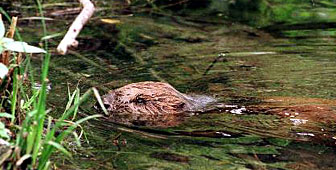Geneva celebrates successful beaver reintroduction

A number of animals have been reintroduced in Switzerland in recent years. One of the most successful beneficiaries has been the beaver. The Natural History Museum in Geneva has a new exhibition celebrating Europe's largest native rodent.
“People love beavers, and their reintroduction has been a real success story,” says Manuel Ruedi, a researcher at the museum.
The exhibition, which will eventually tour local schools, aims to raise awareness about this creature and its lifestyle, and draw lessons from its reintroduction.
It is also a tribute to the naturalist, Maurice Blanchet, and the artist, Robert Hainard, who were responsible for reintroducing the beaver to Swiss rivers in 1956. Some of their work forms part of the exhibition.
“We really wanted to honour the work of these two pioneers,” Ruedi told swissinfo.
The beaver was once widespread throughout Europe, but by the late 19th Century it had died out in Switzerland, hunted to extinction for its fur, its meat and scent glands.
Indeed by the middle of the 20th Century, there were only two significant populations left in Europe: on the River Elbe in eastern Germany and in southern France. It was animals from this French group that were used to repopulate the rivers of canton Geneva.
There are now 50 beavers in this small canton, living in the Rivers Rhone, Arve and Versoix. Some have even ventured into the city itself.
There are between 200 and 300 in Switzerland as a whole, with major colonies existing in canton Berne, the Rhone Valley in canton Valais and in the far north-east.
However, the reintroduction process has not been easy. The spread of the beaver has been limited by roads and dams and by the fact that the zones in which they have been released are not always connected.
“There are a number of good colonies of beaver, but they were all introduced by man. Beavers are very dependent on a good network of rivers, and we do not have a continuous network of rivers. So they have found it hard to colonise new areas,” Ruedi explains.
Beavers are well known for cutting down trees with their formidable incisors. But far from ruining the environment, this can often be beneficial. The felled tree will sprout new shoots, which provide protection and more nutritious food for wildlife.
“There has been no negative impact on the environment. They feed on things that are not eaten by other animals. The have established themselves in a niche that was vacant,” Manuel Ruedi told swissinfo.
“The positive impact is that we have recovered the biodiversity that had been lost,” he added.
Many people are ambivalent about the reintroduction or reappearance of other animals in Switzerland. Farmers and hunters would often prefer not to see lynxes, wolves and even bearded vultures in their area. But the reintroduction of the beaver was very popular.
“The beaver is not a predator and there is no direct conflict with humans,” Ruedi says. “People were very happy to see them reintroduced.”
“Our biggest challenge is to provide the right habitat. We have to find enough space for enough beavers to ensure their long-term survival, and most importantly, we have to provide good connections between these habitats,” he adds.
by Roy Probert

In compliance with the JTI standards
More: SWI swissinfo.ch certified by the Journalism Trust Initiative
You can find an overview of ongoing debates with our journalists here . Please join us!
If you want to start a conversation about a topic raised in this article or want to report factual errors, email us at english@swissinfo.ch.